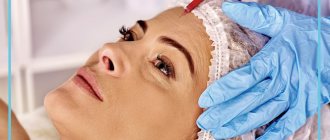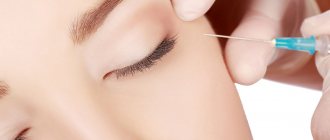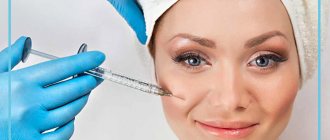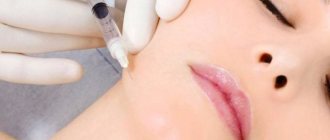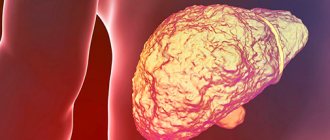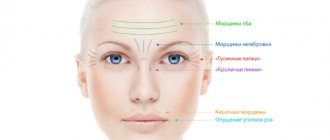Botox: recommendations and contraindications after the procedure
When a patient decides to undergo rejuvenation using botulinum therapy and goes to a cosmetologist’s office, it is very important that the specialist warns him in detail about the restrictions after Botox and provides a full list of recommendations. Not only the effectiveness, but also the safety of the technique depends on how detailed this consultation is. At the same time, such a scrupulous approach should not frighten a person, because we are talking about the simplest precautions after Botox injections, the implementation of which does not require significant effort.
First of all, it is worth saying that Botox injections can be classified as “weekend cosmetic procedures” that do not require a long recovery period from the patient and do not limit performance. The duration of the procedure does not exceed half an hour, and recovery is not accompanied by severe pain or discomfort. At the same time, the minimal trauma of the technique is achieved by using local anesthesia and the use of ultra-thin cannula needles that do not leave marks on the skin.
So, you leave the cosmetologist’s office already young and beautiful and all that remains is to find out what not to do after Botox injections.
Contraindications
- The patient must be between 18 and 60 years of age. This is the ideal time for Botox to work well. After 60, its effectiveness noticeably decreases, because it is not able to change all natural changes in muscle elasticity, especially those caused by age.
- Oncological, respiratory or allergic diseases. You can get a complete and accurate list from a cosmetologist during a consultation.
- Experts give different answers as to why you should not drink alcohol after lip augmentation, but most agree that it is not prohibited, it is simply not recommended. This will not spoil the quality of the injection, but will create additional stress for the body.
- The timing of the injections must be timed so that there is no need to take antibiotics before the procedure. This is necessary so that its effectiveness does not decrease. Otherwise, Botox may not work as well as it should, and you may not be happy with the result.
- Don't overexert yourself before the procedure. Skip the gym and don't be a hero when leaving the store. Physical fatigue will not improve the quality of the injection.
- It is better not to do beauty injections during pregnancy and while breastfeeding. The effect of injections on the fetus and child has not yet been fully studied. It is better not to risk the baby’s health and refrain from going to the cosmetologist at this time.
- Diseases of the liver, kidneys.
- It is better not to do Botox if you have your period, because it will put too much stress on the body, and it will be harder for you to tolerate the procedure.
Can I drink alcohol after Botox injections?
Botox and alcohol are a hot topic and widely discussed on the Internet. Official medicine insists on the incompatibility of these substances, while all-knowing Internet gurus claim that there is nothing wrong with such a combination and they have “done this a hundred times.” So, who to believe and how much alcohol should you not drink after Botox?
You should definitely trust the specialists who list limiting the intake of alcoholic beverages and alcohol-containing medications as one of the main recommendations after Botox injections. Such a strict prohibition is associated with the physiological effect of alcohol, which promotes vasodilation and can lead to accelerated removal of botulinum toxin from the patient’s body or, which is very unpleasant, cause improper distribution of the drug in the muscle. As a result of drinking alcohol after Botox, instead of the expected smooth and youthful skin, you can get a bumpy and visually unaesthetic skin surface.
When answering the question of how much you should not drink after Botox, most experts determine a period of at least two weeks during which the final effect of the procedure is formed. At the same time, some “lucky” ones claim that they did not observe complications, even without maintaining such a non-alcoholic period. This may be due to the individual characteristics of the patient’s body, so you should not conduct such experiments and risk your own health and beauty.
What are Botox injections?
During a botulinum therapy session, the cosmetologist injects botulinum toxin into the facial muscles. The most popular of them, Botox, is injected into the muscles of the upper face.
Botox injections are good for getting rid of facial wrinkles. The active component of the drug blocks the activity of facial muscles, as a result of which wrinkles are smoothed out. The less mobile the facial muscles are, the less deep the facial wrinkles become.
Botulinum toxin products are also used to treat hyperhidrosis and excessive sweating. Botox is not suitable for this purpose because it concentrates in the injection area and does not spread to nearby tissues. Drugs that are more prone to diffusion are injected into the armpits, palms and feet - hyperhidrosis is especially pronounced in these areas.
The session takes about 20 minutes and in most cases is performed without anesthesia - there is no pain, and therefore no anesthesia is required. After 2-7 days, the first results are noticeable, but at this time the facial tissues are most vulnerable. Any careless influence leads to swelling and even impaired facial expressions.
Why can't Botox and antibiotics be combined?
A very important aspect of preparing for botulinum therapy is the need to complete in advance (preferably at least 1 month) all medications that may affect the effect of Botox on muscle tissue. Antibiotics are also among these medications. In particular, you should limit the use of the following medications:
- tetracycline antibiotics - this group of drugs significantly reduces the effectiveness of botulinum toxin, which will not allow obtaining the desired aesthetic result;
- aminoglycoside antibiotics - these drugs, on the contrary, potentiate the effect of the drug, which can lead to such unexpected consequences of the procedure as drooping eyelids and changes in facial contour;
- erythromycin, lincomycin, macrolides, polymyxin - these antibiotics can disrupt the distribution of Botox in tissues, which sometimes causes unpredictable visual consequences;
- muscle relaxants - all medicinal substances that can affect muscle tissue are strictly contraindicated for at least two weeks after Botox injections due to the likely increase in effects;
- aspirin and all anticoagulants - agents that can reduce blood clotting significantly increase the likelihood of bruising and hematomas at the injection sites of Botox.
You should limit yourself from taking antibiotics after Botox injections for 10-14 days. If there is an urgent need for antibiotic therapy, you should definitely inform your doctor about your recent procedure, in order to select the safest combination of drugs.
The effect of alcohol on other botulinum toxin preparations (Botox analogues)
According to official guidelines, alcohol should not be consumed shortly before and for some time after any botulinum toxin injections. This is true for Botox and its analogues - Dysport, Xeomin, Myoblok, Relatox and other drugs.
Due to the lack of evidence, it cannot be said that drinking alcohol has different effects on the effect of different neurotoxin preparations. Moreover, due to the individual reaction to the procedures and to the alcohol itself, the effect of such “taking on the breast” can be completely unpredictable.
On a note
There are theoretical grounds to believe that alcohol intake will have a more pronounced effect on the effect of Xeomin than on the effect of drugs based on a complex of botulinum toxin with auxiliary proteins. It is believed that Xeomin itself, due to its small molecular weight, is more mobile and more inclined to “spread” from the injection site than products with large and massive molecules. Consequently, the likelihood of increased diffusion under the influence of alcohol is presumably higher. But in fact, it was not possible to detect any difference between the pharmacodynamics of Xeomin and other drugs, and therefore such assumptions are most likely only theoretical guesses.
There is no evidence that alcohol has a different effect on the effectiveness of injections of Dysport, Xeomin and other botulinum toxin preparations.
Alcohol affects the consequences of mesobotox procedures in the same way as the effect of injecting botulinum toxins into muscles. Since the fundamental dynamics of the neurotoxin during mesobotox differ little from the distribution of this substance during classical injections, the effect of Botox on these procedures will be approximately the same (that is, up to the complete absence of such an effect).
Review:
“Somehow I didn’t notice the difference between Botox and Dysport at all. They say that Dysport is like diluted Botox; you need to inject it more for the same result. I don’t know how much they injected me, but they did it for 1000 rubles cheaper than with Botox, and the result is the same, it’s been around for 5 months and is very strong. And I wasn't careful this time. When I administered Botox, there were strictly no saunas, fitness classes, or alcohol for 10 days, but here, exactly the day before my child’s name day, I administered it, so the next day I sipped it lightly. But it didn’t affect anything.”
Oksana, Tyumen
It is also useful to read: Is there an alternative to Botox?
Are cosmetic procedures after Botox safe?
Many patients are interested in how much the use of Botox limits cosmetic skin care and when they can return to their usual beauty procedures. In addition, we should separately highlight some procedures that are perfectly combined with botulinum therapy, enhancing the rejuvenation effect.
- Is it possible to do a facial massage after Botox? Facial massage after Botox can cause uneven distribution of the drug in the muscles, so such effects should be avoided for 24 hours after Botox administration. It is advisable not to touch your face or use cosmetics during this period in order to protect yourself as much as possible from the development of side effects;
- Is it possible to do biorevitalization after Botox? Injection of hyaluronic acid into subcutaneous structures, which in cosmetology is called biorevitalization, helps moisturize and rejuvenate the skin. Moreover, this procedure is perfectly compatible with Botox injections and can be performed even on the same day;
- Is it possible to peel after Botox? As for peeling effects, it is still better to refrain from combining it with Botox for 24 hours. This is especially true for aggressive types of peeling, such as microdermabrasion.
Non-alcoholic drinks and alcohol-based medications
Doctors are unanimous about various non-alcoholic drinks: you can drink them both before and after the procedure. Such drinks do not affect the effect of Botox. Occasionally, individual specialists may recommend that their patients not drink coffee for 24 hours after the procedure, but this precaution is, in general, redundant.
Non-alcoholic beer, champagne, mojito, drinks such as kvass, light cider with a strength of up to 3% can also be drunk after botulinum therapy. Of course, observing a certain measure - if desired, you can drink enough kvass to get drunk.
It is not recommended to use various alcohol-based medications internally (tinctures, extracts). At a minimum, such products often contain more alcohol than standard alcoholic drinks, which means they can have a greater effect on the effect of botulinum toxin.
It is not recommended to use alcohol-based medications after botulinum therapy.
But something else is more important: if a patient really needs to take medication for some time, it means he is unhealthy, and in such a state it is not entirely justified to carry out serious cosmetic procedures. The situation here is similar to botulinum therapy when taking antibiotics or antipyretics. Botox usually doesn’t “work”, and you must first complete the treatment, and after completing the course of taking this or that medication, carry out botulinum therapy.
On a note
It is not recommended to wipe your face with alcohol-containing lotions after Botox injections. Alcohol is absorbed into the skin and penetrates into the tissue underneath, dilating blood vessels, which can cause the same effect on the effectiveness of Botox as drinking strong alcohol.
In conclusion, it is worth noting that even if the doctor has allowed you to drink alcohol, you may be one of those few percent of the “lucky” ones for whom alcohol caused side effects and negatively affected the result of the procedure. Therefore, for maximum safety, it is advisable to abstain from alcohol - it definitely won’t hurt anyone.
The myth about the ban on drinking alcohol after botulinum therapy
Side effects after Botox
Side effects of Botox are extremely rare and are most often the result of an incorrectly performed drug administration procedure or the result of non-compliance with post-procedure recommendations. The composition of Botox itself does not have any significant toxicity to the body and is not capable of causing complications or unpleasant consequences.
The most common side effects of Botox include:
- Swelling after Botox . Many patients are interested in what to do if Botox causes swelling under the eyes or in other facial areas. This complication occurs in approximately 4% of patients and, depending on the severity and location, may resolve on its own or require additional correction. The most unpleasant option is eye swelling after Botox, which is recommended to be eliminated with medication and physiotherapy;
- Headache . About 2% of patients experience headaches after Botox, which is corrected by taking mild analgesics;
- Eyelid ptosis after Botox . Another rare complication of the procedure is ptosis (drooping) of the upper eyelid, which occurs in no more than 1% of patients. Treatment of ptosis of the upper eyelid after Botox is usually not carried out, since after 2-3 months, after the drug is removed from the body, muscle tone is restored on its own. The same rule applies to those cases where the eyebrows have drooped after Botox;
- Hematomas . They develop after injections in 6% of patients and go away on their own within 3-4 days.
A guarantee of the absence of side effects and complications after Botox will be the qualifications of the cosmetologist and strict adherence to all post-procedure recommendations. The NEOMED clinic is ready to provide cosmetology services using safe drugs and under the supervision of experienced professional cosmetologists.
Find out the cost of the Botox procedure
Complications
Failure to follow care recommendations and incorrect administration of the drug into facial tissues lead to undesirable consequences.
Bruises and swelling on the face can occur from drinking alcohol, poor diet, or bending over.
Exposure to high temperature causes migration of the drug, and with it ptosis - drooping of the eyelid. Another cause of ptosis is long-term use of botulinum toxin preparations for rejuvenation. Over several years of regular treatments, the muscles into which Botox is injected weaken.
Sometimes after the procedure the patient experiences double vision. This side effect occurs due to the injection of too large a dose or near the edge of the orbit. Double vision indicates weakening of the eye muscles from the action of botulinum toxin.
A little about rejuvenation and the products used
Nowadays in cosmetology, wrinkles are smoothed out with preparations containing botulinum toxin. This protein belongs to the group of organic poisons. It is produced by the bacteria Clostridium botulinum. The effect on the human body depends on how much of the substance was administered. A large dose of botulinum toxin causes severe toxic damage. Protein, introduced in small quantities, relaxes muscles.
Botox, which refers to drugs containing botulinum toxin, is now a popular method of rapid rejuvenation. Modern remedies are harmless. Some drugs with botulinum toxin are even used in the medical field in the treatment of blepharospasm, spastic diseases, etc.
